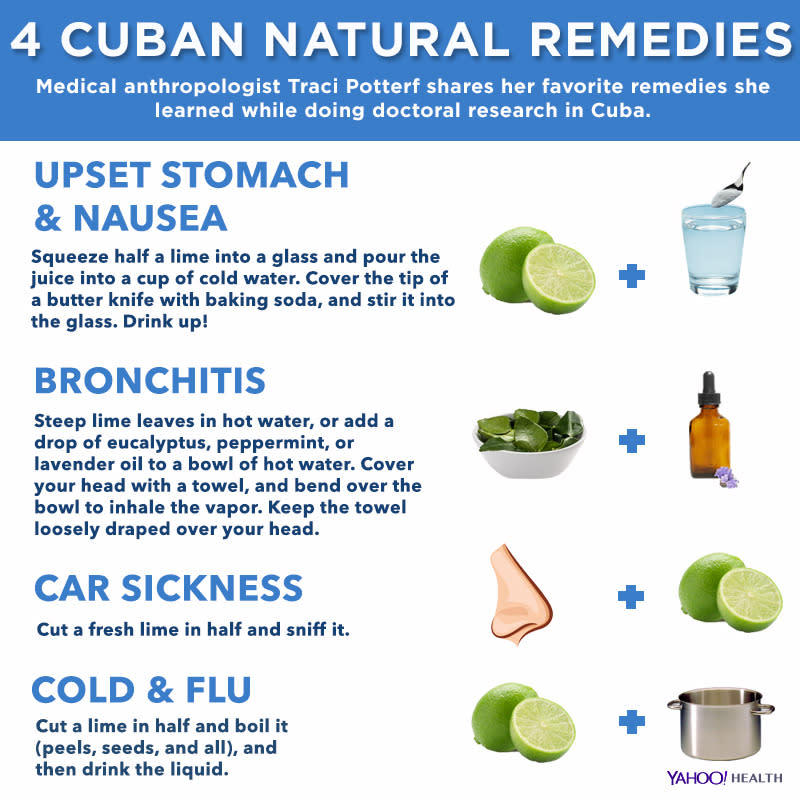How Plant-Based Medicine Filled a Void in the Cuban Health Care System

Cubans call plant- and herb-based cures “el invento cubano,” referring to their need to be resourceful due to lack of access to modern medicine. (Photo: Yahoo Health)
Back in 2006, when medical anthropologist Traci Potterf was conducting doctoral research in the Cuban city of Baracoa, she found herself getting sick often. Some of her ailments were simple — colds, coughs, common stomach bugs — but she was also hit by more serious problems, including the intestinal infection giardia, chronic bronchitis, and kidney issues.
Like any other resident in Baracoa, Potterf was prescribed a cocktail of treatments by a local doctor, including allopathic (traditional) medicines, plant-based remedies, and even spiritual guidance. These are all commonly prescribed treatments in Cuba, where the medical system is a creative mélange of various strategies that evolved from the penury the island endured during its decades-long isolation from the rest of the world.
Plant- and herb-based cures are an important part of this mix, which the locals call “el invento cubano.” They have helped fill the gaps created by scarcity. Concocting these remedies meant having to delve into traditional medicinal knowledge that in the early part of the Castro regime was forbidden, despite plenty of scientific evidence in its favor, Potterf says. But the evolution of plant-based medicine, or “Medicina Verde” as it is referred to locally, has brought Cubans closer to nature, she says, and imbued them with a sense of how nature works: the ability to know, for instance, whether a particular type of food, herb, or plant is antimicrobial or anti-inflammatory, and whether it might successfully treat a particular condition.
Related: 7 Disease-Fighting Plants You Need To Be Eating
“In Cuba, tradition and science are not diametrically opposed, but intricately interwoven, from doctors to lay people,” Potterf, who’s also the founder of Ola Loa Wellness in Kailua, Hawaii, tells Yahoo Health.
To this day, Potterf uses some of the plant-based remedies she was prescribed in Cuba and that she found to be effective. However, she also cautions that the Cuban medical model has its limitations — and this also applies to the more “nature-based” protocols.

(Infographic: Nadeen Nakib for Yahoo Health)
In reality, Cuba’s Medicina Verde is still a work in progress. It is in serious need of funding and, in many cases, lacks solid scientific research to back it up. Although natural remedies can be very successful, they can also fail, Potterf says, because of a lack of in-depth knowledge on a particular plant’s or herb’s properties and effectiveness. That lack of knowledge is largely because Cuban health care is poorly funded, so extensive research on the medicinal properties of plants has simply not been possible. “I experienced it myself, and I saw plenty of people getting better using traditional medicine and herbs. But people sometimes make up remedies that are not well researched and that don’t have a strong foundation in traditional medicine, and, not surprisingly, they don’t always work,” Potterf says. And worse, they can be dangerous.
Plants have extremely powerful healing properties, but the difference between a therapeutic dose and a toxic dose can be very small, which is why the scientific preparation of plant-based pharmaceuticals is crucial, says Katherine Hirschfeld, associate professor of anthropology at the University of Oklahoma. This is lacking in Cuba, where patients are often “forced to accept unproven plant preparations instead of scientifically verified, double-blind placebo-tested pharmaceuticals — something that would be considered malpractice in the United States or Europe,” Hirschfeld explains.
Related: How To Make A Medicinal Tincture, Just In Time For Cold and Flu Season
According to J.E. Williams, an integrative medicine practitioner and naturopath with offices in Sarasota, Fla., who has been to Cuba often, the country’s health care system is overloaded and underfunded. During the so-called “Special Period,” after the fall of the Soviet Union, when funding dried up and few drugs were available, plants filled in out of “dire necessity,” Williams says. Resources were put into researching medicinal plants and herbs and figuring out whether some could be formulated in a lab to be more effective. Over the years, the research has expanded to include other products, such as placenta extract for the treatment of vitiligo (a chronic condition that causes the loss of skin color in blotches) and blue scorpion extract for cancer.
However, “Cuban doctors quickly found that natural products had limitations and discovered that they were best used as complements to modern drugs,” Williams says. “A severe urinary tract infection, for instance, would be treated with a short course of antibiotics and two herbal tinctures, one to be taken along with the antibiotic and the other after finishing the antibiotic course.”
In Potterf’s view, the Cuban model can serve as an example to the United States, where there is more ignorance of the “connections to nature and connections to food, and where we put these artificial social barriers between doctors and patients rather than having a shared sense of humanity.”
“Cubans thrived in the harsh economic situation of the U.S. embargo; they learned to get along and help each other,” Williams adds. “What we can learn, and should practice, is getting along with less, taking better care of each other, and simplifying our lifestyle.”
More stories on this topic >>>
Read This Next: Science Affirms Benefits of Chinese Herbs — But Not in the Way You’d Think


